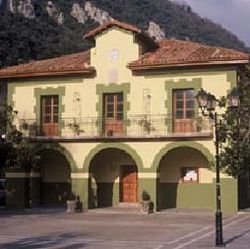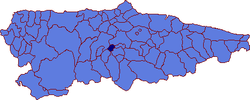|
Santo Adriano
Santo Adriano (Asturian: Santu Adrianu) is a municipality in the Autonomous Community of the Principality of Asturias. It is bordered on the north by Oviedo, on the east by Ribera de Arriba and Morcín, on the south by Quirós and Proaza and on the west by Proaza and Grado. Geography It is one of the smaller municipalities in Asturias in both area and population. Like the majority of the rural areas in Asturias, the population is receding. The highest point in the municipality is Grandamiana, at 813 m. Afterwards are Los Navalones at 756 and El Piantón at 750. Fifty-eight percent of the municipal area is between 400 and 800 meters high. Nearly a quarter of the area has a slope of more than 50%. The lowest point is along the Trubia River, at 140 meters. In addition to the Trubia, which crosses the territory from south to north, there are many small arroyos which flow into it, such as the Picarós, the Rebregáu, the Tresarcu and the Xanas. The latter flows along the Xanas Pass, which is one of the more beautiful sights in the area. Parishes
DemographicsThe municipality reached its highest population in the year 1900, with 1,747 inhabitants. Since then, the loss of population has been notable, as is the case in most Asturian mountain municipalities. The large part of the movement is due to the migration of many inhabitants to Oviedo, especially for working in the arms factory in Trubia parish. Currently (as of the 2005 census), the majority of the population is over 40 years in age and there is little generational replacement, which causes the municipality to be the third smallest in Asturias in population.  EconomyThe principal economic activity of the municipality is ranching, especially with cattle. The most common breed of cattle is the Asturiana de los Valles, which is bred for meat. Agriculture is generally practiced for subsistence. The industrial sector is practically zero, as the proximity of the arms factory in Trubia takes nearly all the workers. In contrast, the service sector employs 56% of the employed population, and has experienced growth in recent years due to activities related to the natural surroundings and its associated business. Politics
In the last municipal elections (2003), the municipality voted in an absolute majority for the Spanish Socialist Workers' Party, and elected Carlos de Llanos González as mayor. Famous people
ArtThe most notable building in the municipality is the temple of Santo Adriano de Tuñón, which was ordered built by Alfonso III of Asturias and his wife the queen Jimena in 891. The church is dedicated to the martyrs Adriano and his wife Natalia. It was restored in 1108 and 1949, and was declared a National Historical Monument in 1931. It is in a basilica plan, divided into three naves which are connected by arches, with a large portico in one large room. On the opposite side is a cemetery. The construction techniques include masonry and ashlar. The other notable structure is the "Roman" bridge across the Trubia River, which dates from the medieval period. It consists of a 1.5-m-high arch and is 4 meters wide between railings. References
External links
|
||||||||||||||||||||||||||||||||||||||||||||||||||||||||||||||||||||||



